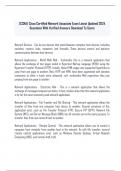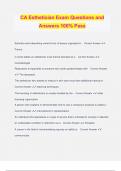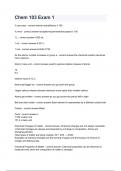(CCNA) Cisco Certified Network Associate Exam Latest Updated 2024 Questions With Verified Answers Download To Score Network Devices - Can be any devices that stand between computer host devices, including switches, routers, hubs, repeaters, and firewalls. These devices control and optimize communication between host devices. Network Applications - World Wide Web - Technically, this is a network application that allows the exchange of text pages coded in Hypertext Markup Language (HTML) using the Hypertext Transfer Protocol (HTTP). Initially, these HTML pages only supported hyperlinks to jump from one page to anoth er. Now, HTTP and HTML have been augmented with dynamic extensions to allow a much more advanced, rich, multimedia Web experience than just jumping from one page to another. Network Applications - Electronic Mail - This is a network application that allow s the exchange of messages between two hosts. In fact, studies show that this network application is by far the most commonly used network application. Network Applications - File Transfer and File Sharing - This network application allows the transfer of files from one computer host device to another. Several variations of this application exist, such as File Transfer Protocol (FTP), Secure FTP (SFTP), Network File System (NFS), and Server Message Block (SMB), but all versions serve the same purpose: To transfer files from one network host to another. Network Applications - Remote Control - This network application allows you to control a computer host remotely from another host in the network. As with file transfer, several remote control applications ex ist, such as Windows Remote Desktop, Virtual Network Computing (VNC), and remote shell (rsh). Network Applications - Voice over IP (VoIP) and Video over IP - This network application allows the transfer of voice and video signals over the Internet Protoco l. Many Web sites stream video over the Internet today. These sites use some VoIP network application to wrap their video content in IP packets and send them over the network to the computer host that requested the streamed video content. Another example o f VoIP is Cisco IP phones, which are being adopted today by many organizations to save costs by concentrating their phone and data traffic over the same IP infrastructure. Network Applications - Shared Network Storage - This network application connects advanced specialized storage devices to a storage network, making them accessible to any computer host connected to that storage network. Storage networks can be either • Isolated, that is, connecting only to a few computer hosts locally • Connected to othe r data networks Network Applications - High Availability (HA) and Parallel Processing - This network application enables computer hosts to act as a single logical host, sometimes also called a "Computer Cluster". The hosts use clustering software that man ages the logical "supercomputer." The clustering software needs to have those physical computers interconnected in a network. Purpose of Computer Networks - Computer networks were developed to aggregate the computing power of several individual computers into initially local networks, then campus networks, then metropolitan networks, then countrywide networks, and finally, global networks. A computer network is a group of computer host devices that communicate with each other. Computer Host Devices - - Can be any other devices used to access the network, including servers, workstations, personal computers, smart phones, and lapto ps. - A network host is a computer or other device connected to a computer network. A host may work as a server offering information resources, services, and applications to users or other hosts on the network. Hosts are assigned at least one network addr ess. Computer clusters are used for the following: • High availability: Several levels of high availability exist, but generally speaki ng, HA implies that whenever one of the physical computers in the cluster fails, the remaining computer(s) takes over the load of the failed computer. • Parallel Processing: In parallel processing, all physical computers in the cluster can process data at the same time, thereby improving processing speed and reliability. Both HA and parallel processing require a network connection between the physical computer hosts involved. Hub - - A simple network can be three hosts connected to a hub. A hub works very much like a multiplexer, or a multiple socket power bar: Hosts connect to the hub, and they can "speak" and "hear" each other. - An Ethernet hub, active hub, network hub, repeater hub, multiport repeater, or simply hub is a network hardware device for conn ecting multiple Ethernet devices together and making them act as a single network segment. It has multiple input/output (I/O) ports, in which a signal introduced at the input of any port appears at the output of every port except the original incoming. A h ub works at the physical layer (layer 1) of the OSI model. A repeater hub also participates in collision detection, forwarding a jam signal to all ports if it detects a collision. - A hub is basically a multiplexed connection device: All devices connected to a hub can send frames to all other devices connected to the hub. A hub sends frames it receives on all ports, except on the port where the frame is received. Thus, even if a frame is only addressed to one of the six hosts plugged in to the hub, in reali ty, all five hosts, other than the sending host, will receive the frame. Four hosts will have to discard the frame because it is not addressed to them. Some hubs also amplify the electrical signal before sending it on all ports other than the originating p ort. Those hubs are also repeaters. Domain Name System (DNS) - Query a name server, also known as a Domain Name System (DNS) server to obtain the IP address for the name. DNS servers keep tables of host names and their corresponding IP addresses. Whenever they are queried for the IP address of a host, they search the host name in their table, and if they find it, they return the IP address. The logical IP address can be used to obtain the physical (MAC) address to establish a connection between the NICs. I n a small network, a host can simply broadcast a request to obtain another host's MAC address. The broadcast is sent to the data link layer broadcast address, which is FF:FF:FF:FF:FF:FF. This is the standard broadcast address to query for MAC addresses. In larger networks, the amount of requests on the data link layer would harm performance. Thus, it is best to limit the size of the network. "Noise" Generated by Broadcast Queries - One computer sends a broadcast query to every other device in the network t o obtain an IP address or a MAC address, and eventually the target computer responds. Meanwhile, all computers in the broadcast domain have "heard" the broadcast request. They were disturbed by a request that does not concern them. If lots of broadcast req uests are being sent on the network by hosts that just joined the network, for example, a broadcast storm can occur: Everyone is disturbed by everyone's broadcast request, and the network performance is considerably impacted. Message Collision - After two computers know about each other and they start to communicate, they send data frames on the link that is shared by all other computers in that network segment. If two computers try to send frames at the same time, on the same wire, the frames collide. In that case, both computers back off: They stop sending frames, they wait a little while, and they try to resend. You have no guarantee that the frames will not collide again when they are resent. Typically, there are few chances that they collide again, because the two computers wait random time periods that are likely different. However, collisions do happen, and they can slow a network considerably. The more hosts you add to a network segment, the more chances of having frame collisions. It's best to keep network segments as small as possible. Switch - - You can segment a network using a data link layer switch instead of a hub. Data -
link switches are also called Layer 2 switches, because the data link layer is the second layer in the TCP/IP protocol stack. Switches segment networks into one collision domain per port. A collision domain is a logical space where messages can collide. - A network switch (also called switching hub, bridging hub, officially MAC bridge) is networking hardware that connects devic es on a computer network by using packet switching to receive and forward data to the destination device. A network switch is a multiport network bridge that uses MAC addresses to forward data at the data link layer (layer 2) of the OSI model. Some switche s can also forward data at the network layer (layer







